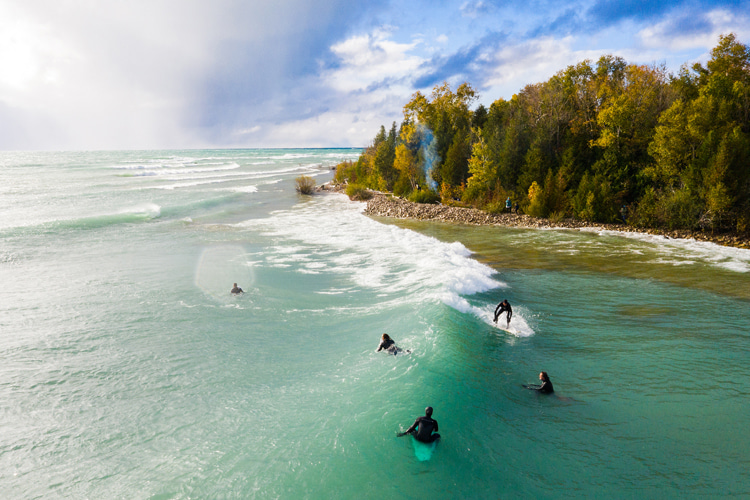Surfing in the Great Lakes is an exhilarating experience. Here's everything you need to know about this freshwater wave-riding paradise.
The Great Lakes - also known as The Laurentian Great Lakes or The Great Lakes of North America - are a series of large interconnected lakes located in a Canadian-American region.
They occupy zones in eight US states (Illinois, Indiana, Michigan, Minnesota, New York, Ohio, Pennsylvania, and Wisconsin) and one Canadian province (Ontario).
The Great Lakes are the largest group of freshwater lakes on the planet by total area (94,250 square miles or 244,106 square kilometers) and the second-largest by total volume (5,439 cubic miles or 22,671 cubic kilometers).
They feature 21 percent of the world's surface fresh water by volume.
The Great Lakes consist of five water basins: Lake Superior, Lake Michigan, Lake Huron, Lake Erie, and Lake Ontario.
They're all interconnected through a system of artificial canals and natural channels and connected to the Atlantic Ocean via the Saint Lawrence River.
The Great Lakes coastline measures approximately 10,500 miles (16,900 kilometers), so it is commonly called the USA's "Third Coast."
These enormous lakes enjoy a humid continental climate and are influenced by mild Pacific air masses from the west, then dry, cold Arctic systems from the north, and wet tropical systems from the south and the Gulf of Mexico.
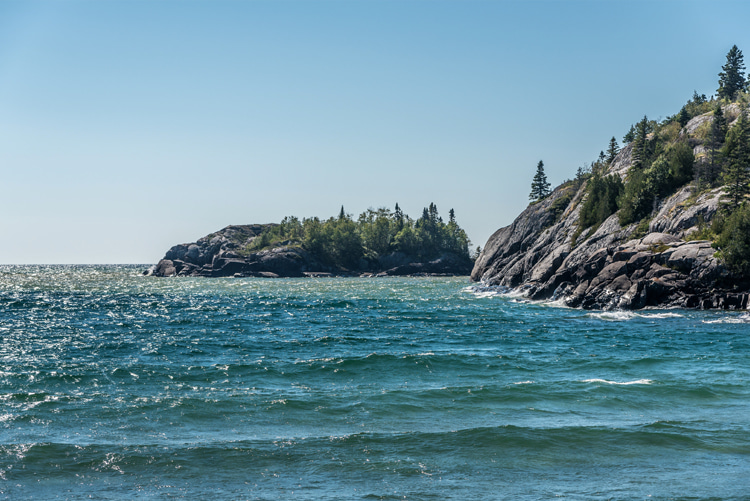
A Landlocked Freshwater Surfing Experience
Can you surf on the Great Lakes? Yes, you can.
The first surfers hit Lake Erie in Buffalo, New York, in the 1960s, although there are reports of wave riding activities in the region in the late 1940s.
Since then, the local surfing community has never stopped growing.
Actually, the Great Lakes are known for being inland seas due to their ocean-like characteristics.
A casual observer will be able to see distant horizons, swim and dive at great depths, experience powerful currents, and ride natural waves thanks to occasional strong and sustained winds.
Although the Great Lakes do not have enough area to generate groundswells, they do have enough space for wind swells to create highly surfable waves.
However, there are always a few problems - or challenges - lake surfers often face when hitting their local surf spots.
They have to paddle out in choppy waters, strong onshore winds, and short wave periods of four to five seconds.
As a result, local surfers are forced to duck dive several times in freezing waters, resulting in agonizing brain freezes.
And to make things even more difficult, they're surfing in freshwater bodies, which means less buoyancy and more drag.
To compensate for the loss of flotation compared to ocean waves, surfers tend to pick larger, wider, and thicker surfboards.
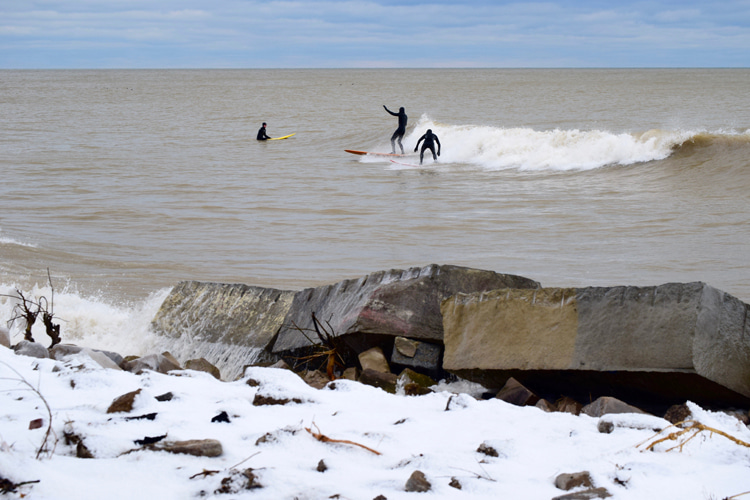
Wind Swells and Low Temperatures
How big do the waves get in the Great Lakes?
If you're a Great Lakes surfer, you'll have to wait for powerful storms in order to get the biggest waves.
"Those storms blowing over the long fetches in Lake Superior and Lake Michigan create beautiful reef and point breaks that entice hardy American and Canadian surfers into brutal conditions, notes Benjamin Marcus, author of "Extreme Surf."
Consequently, local riders have short windows of opportunity to ride sizeable waves. In most cases, one to three days; luckily, ten consecutive days of good ripples.
The best time to surf the Great Lakes is during fall and winter.
That means you'll be putting on a 5/4 or even 6/5 wetsuit in snowy conditions and air temperatures ranging from -13 to -41 °F (-10 to 5 °C) and water temperature at 33 °F (0.5 °C).
Super thick wetsuits or drysuits, hoods, boots, gloves, and earplugs are mandatory between September and April.
Upon hearing predictions that winter storms are going to hit the Great Lakes, local surfers drive dozens, if not hundreds, of miles in search of the best conditions.
Which Great Lake is best for surfing? You will find waves in all five lakes.
Lake Superior, Lake Erie, and Lake Ontario are oriented in the same direction as most of the storms in the region, courtesy of the polar jet stream.
As a result, winds blow across the water for greater distances, allowing swells to build and reach each lake's eastern coastline with more quality.
"The surf of the Great Lakes is remarkable for the quality of the waves produced in a short fetch in fresh water, also for the brutality of the winter conditions," adds Marcus.
In the documentary "Unsalted: A Great Lakes Experience" produced by Vince Deur, you'll see surfers fully suited walking over snow and falling through ice sheets to reach the surf.
With the windchill reaching -10 °F (-23 °C), it's always going to be the ultimate cold water surfing experience.
Local surfers often carry hot water containers in the car trunk so that they can enjoy a post-session warm shower while taking their wetsuits off in near-artic temperatures.
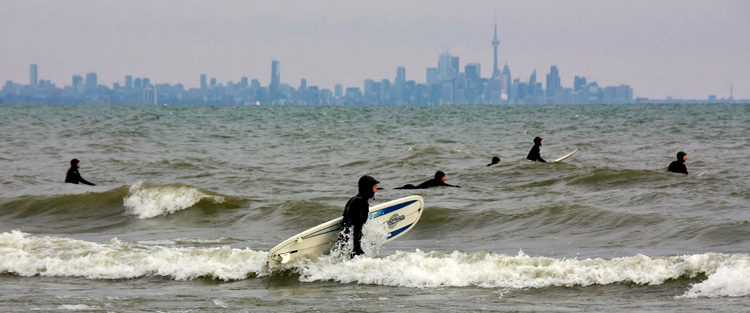
Summer Vs. Winter Surf
Most of the surfable waves you'll find range from three to six feet.
But one must never forget that the Great Lakes freighter SS Edmund Fitzgerald sank on November 10, 1975, after being hit by storm-generated, 35-foot waves.
Can you surf the Great Lakes in the summer?
Yes, you may find surf during the warmest time of the year.
Nevertheless, during summer, wind swells are less frequent and may not be strong enough to create localized rideable waves.
Therefore, surfing conditions in the Great Lakes during summer are less consistent. The trick is to track potential opportunities using online surf forecasting tools and to join chat groups.
However, if you're still learning to surf, the Great Lakes may very well deliver the one-foot rollers you need to get started.
When is the best time to surf the Great Lakes?
The peak surfing season in the Great Lakes is between mid-September (late summer) and early April (early spring).
Great Lake surfers need winds of 18.6 miles per hour (30 kilometers per hour), blowing consistently for three to four hours, to generate a decent swell.
Also, the larger the temperature differences between air and water, the greater the chances for swells to occur.
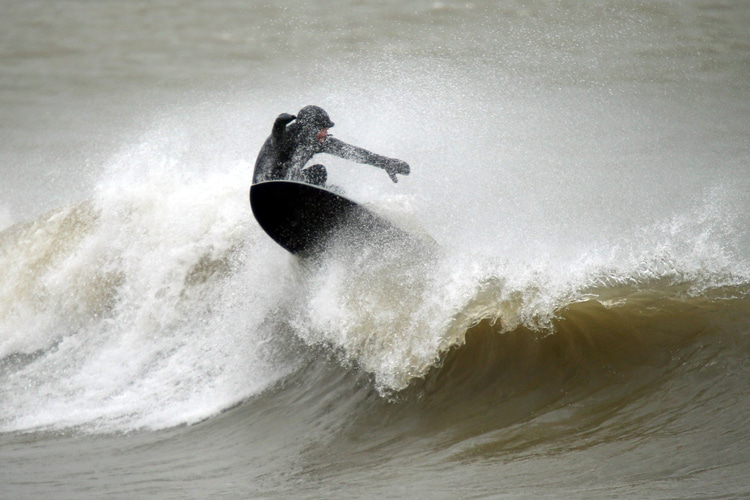
The Best Surf Spots in the Great Lakes
The Great Lakes' landlocked surfing scene is growing fast, and the number of surf shops accompanied this growth.
The downsides? Water pollution and global warming are the biggest threats to surfing in the Great Lakes.
You should also pay attention to tricky rip currents, piers and jetties, rocky bottoms, and, obviously, hypothermia.
On the other hand, there are no sharks and no salt water damaging neoprene, leashes, and boards.
Depending on the direction and intensity of the wind, all Great Lakes have waves for surfing.
In Lake Superior, the best surf spots are Marquette, Grand Marais, The Zoo, Beaver Bay, and Stoney Point.
In Lake Michigan, there are plenty of quality surf breaks.
Check Seol Choix Point, Elbow and North Point (Sheboygan), Milwaukee, Racine, Illinois Beach, Wilmette Harbor, Chicago (North Avenue Beach, Montrose, 57th St., Rainbow, and Osterman), Beverly Shores, Michigan City, New Buffalo, South Haven, Holland, Grand Haven, Muskegon, Montague, Empire, Charlevoix South Pier, Whiting, Pere Marquette Park, Sleeping Bear Dunes, Wind Point, and St. Joseph.
In Lake Huron, the best surfing waves break at Bay City, Forester/Sanilac, Lakeport, Lexington, Port Austin, Port Huron, Kincardine, Port Elgin, and Georgian Bay.
In Lake Erie, surfers normally paddle out at Edgewater/Pinched Loaf, Hamburg Beach, Luna Pier, Point Abino, Port Maitland, Reebs Bay, and Sterling State Park.
In Lake Ontario, you should definitely check Ashbridges Bay, Bluffers Park, Cherry Beach, Frenchmans Bay, Hanlan's Point Beach, Jack Darling Park, Lakeside Park Beach, Olcott Beach, Presquile Point, Sandbanks, Sodus Point, St. Catharines (Municipal Beach), Wolfe Island, Toronto (Scarborough Bluffs), and the Niagara river mouth.
Surfing the Great Lakes is a challenging adventure, especially for the tight crew of landlocked wave riders that hit the region's best surf breaks.
Many times, it's an exercise of masochism - ice beards are a common picture here.
But in the end, it always creates long-lasting memories of epic surf sessions in uncrowded places.
For more information, follow the Great Lakes Surfing Association on social media.
